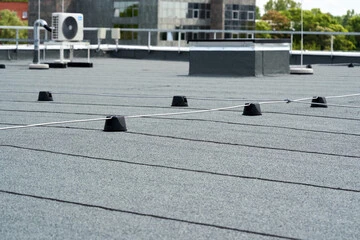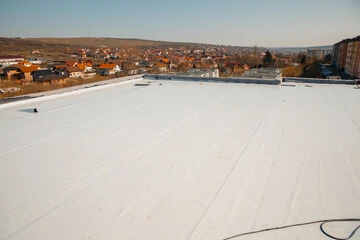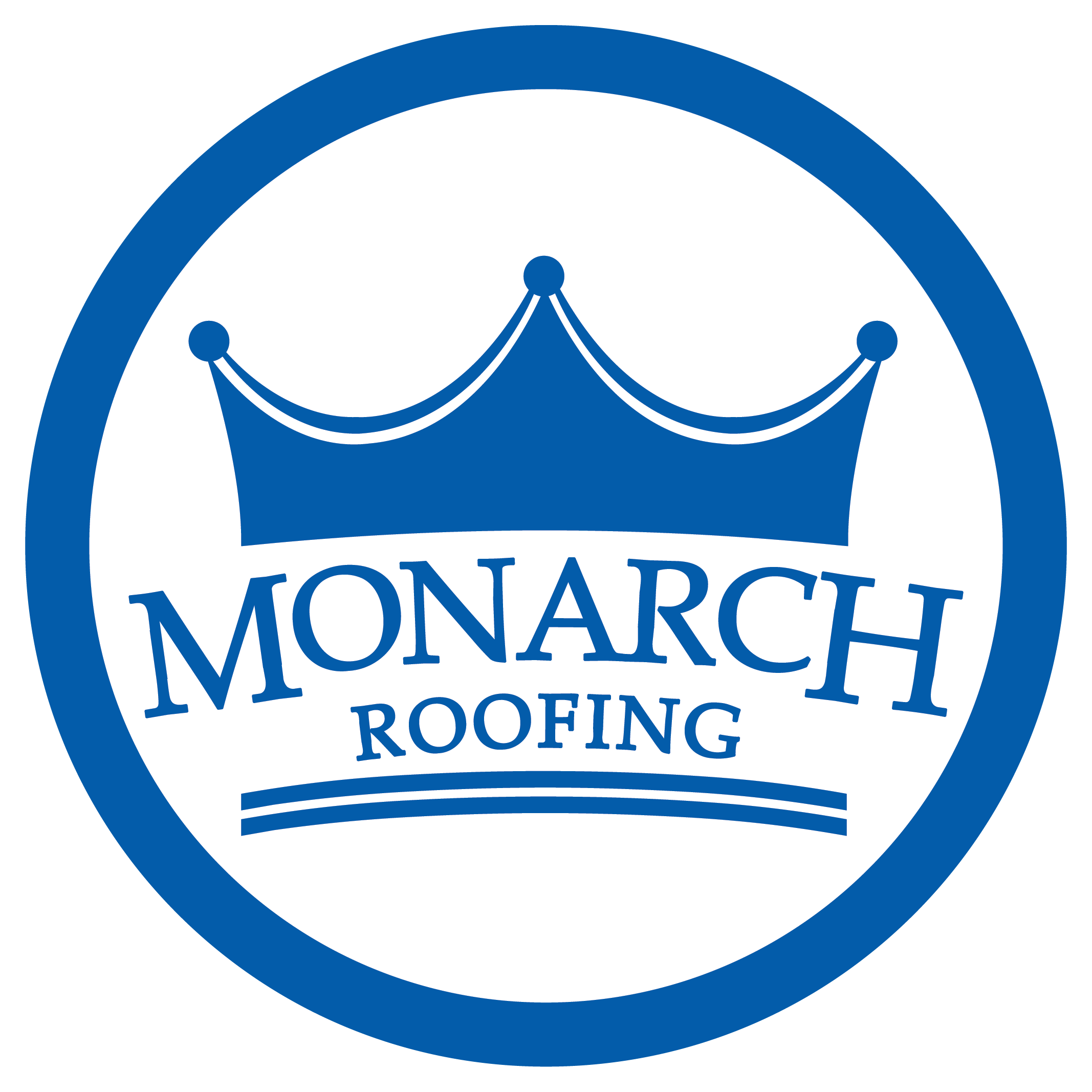When it comes to choosing the right roofing material for your business, flat roofs present a unique set of challenges and opportunities. With the advent of new technologies and materials, the options available in 2024 are more varied and effective than ever before. This guide will explore:
- Key considerations when choosing flat roof materials
- 8 types of flat roof materials and their pros and cons
🤔 Key Considerations When Choosing Flat Roof Materials:

Selecting the right material for your flat roof is vital to ensure durability, energy efficiency, and long-term performance. Understanding the benefits and limitations of different flat roof materials can help you make an informed decision that best suits your needs and budget.
- Climate: Consider the typical weather conditions your roof will face, including temperature extremes, precipitation, and wind.
- Building Use: The nature of your business operations can influence the best roofing material. For instance, roofs with heavy foot traffic might benefit from more durable materials.
- Budget: Balance initial installation costs with long-term maintenance and energy savings.
- Environmental Goals: If sustainability is a priority, materials like TPO, green roofs, and metal roofing might align better with your goals.
💡 8 Types Of Flat Roof Materials

Choosing the appropriate flat roof material for your business is essential to balancing cost, durability, and energy efficiency. In this section, we’ll explore various flat roof materials to help you make an informed decision tailored to your specific commercial needs.
1. Thermoplastic Polyolefin (TPO)
Overview
Thermoplastic Polyolefin, commonly known as TPO, is a single-ply roofing membrane that has gained popularity due to its durability, energy efficiency, and cost-effectiveness.
Advantages
- Energy Efficiency: TPO membranes are highly reflective, reducing the heat absorbed by the building and thereby lowering cooling costs.
- Durability: TPO roofs are resistant to tears, punctures, and impacts, making them ideal for areas with heavy foot traffic or harsh weather conditions.
- Eco-Friendly: TPO is 100% recyclable and free from harmful chemicals, aligning with green building standards.
- Cost-Effective: Compared to other materials like PVC, TPO offers a balance between performance and cost.
Disadvantages
- Seam Integrity: The seams of TPO membranes can be vulnerable if not properly installed, leading to potential leaks.
- Variety in Quality: The quality of TPO can vary significantly between manufacturers, so it is crucial to choose a reputable supplier.
2. Ethylene Propylene Diene Monomer (EPDM)
Overview
EPDM is a synthetic rubber membrane known for its durability and longevity. It has been a staple in the roofing industry for decades.
Advantages
- Longevity: EPDM roofs can last 25-30 years or more with proper maintenance.
- Flexibility: This material remains flexible in a wide range of temperatures, which helps prevent cracking and damage.
- Ease of Installation: EPDM can be installed in large sheets, reducing the number of seams and potential leak points.
- Cost-Effective: Generally, EPDM is less expensive than other flat roofing materials, particularly in initial costs.
Disadvantages
- Aesthetics: Typically available only in black or white, EPDM lacks the variety of colors and finishes found in other materials.
- Vulnerability to Punctures: Although durable, EPDM can be susceptible to punctures from sharp objects or heavy equipment.
3. Polyvinyl Chloride (PVC)
Overview
PVC roofing membranes are renowned for their strength and long-lasting performance. They are commonly used in commercial applications where chemical resistance and durability are paramount.
Advantages
- Chemical Resistance: PVC is highly resistant to chemicals, making it ideal for roofs exposed to industrial pollutants or grease.
- Energy Efficiency: With high solar reflectivity, PVC roofs help reduce energy costs by keeping buildings cooler.
- Fire Resistance: PVC membranes are inherently fire-resistant, adding an extra layer of safety.
- Durability: These roofs can withstand heavy foot traffic and harsh weather conditions, ensuring a long service life.
Disadvantages
- Cost: PVC roofing systems tend to be more expensive than TPO or EPDM, both in initial installation and maintenance.
- Environmental Concerns: The production and disposal of PVC involve toxic chemicals, which can be a concern for environmentally-conscious businesses.
4. Modified Bitumen
Overview
Modified bitumen roofing is a type of asphalt-based roofing that is modified with polymers to enhance its performance. It is often applied in layers, providing a durable and waterproof surface.
Advantages
- Durability: Modified bitumen is highly durable and can withstand various weather conditions, including extreme heat and cold.
- Waterproof: This material offers excellent waterproofing properties, reducing the risk of leaks.
- Ease of Repair: Any damage to a modified bitumen roof can be relatively easy to repair, extending its lifespan.
- Cost-Effective: While more expensive than traditional built-up roofs, modified bitumen is generally less costly than high-end materials like PVC.
Disadvantages
- Heat Application: Installation often requires a heat source (torch-down), which can pose safety risks if not handled properly.
- Aesthetics: Modified bitumen roofs typically lack the aesthetic appeal of other roofing materials.
5. Built-Up Roofing (BUR)
Overview
Built-up roofing (BUR) systems, also known as “tar and gravel” roofs, consist of multiple layers of bitumen and reinforcing fabrics. This traditional roofing method has been used for over a century.
Advantages
- Proven Performance: BUR has a long track record of reliability and performance in various climates.
- Durability: The multiple layers provide excellent protection against weathering and physical damage.
- Excellent Insulation: BUR systems offer good insulating properties, helping to regulate building temperatures.
- Low Maintenance: Once installed, BUR roofs require minimal maintenance.
Disadvantages
- Installation Complexity: The installation process is labor-intensive and can be time-consuming.
- Weight: BUR systems are heavy, potentially requiring additional structural support.
- Cost: Due to the materials and labor involved, BUR roofs can be more expensive than other options.
6. Spray Polyurethane Foam (SPF)
Overview
Spray Polyurethane Foam (SPF) is a roofing material that involves spraying a foam that expands and solidifies into a durable, seamless layer. It is gaining popularity for its insulation and waterproofing capabilities.
Advantages
- Seamless Application: SPF creates a seamless, monolithic barrier that minimizes the risk of leaks.
- Energy Efficiency: SPF roofs offer superior insulation, reducing heating and cooling costs.
- Quick Installation: The spray application allows for fast installation, minimizing disruption to business operations.
- Lightweight: SPF is lightweight, reducing the need for structural reinforcement.
Disadvantages
- UV Sensitivity: SPF roofs require a protective coating to shield them from UV damage, which can add to maintenance costs.
- Initial Cost: The initial installation cost can be higher than other flat roofing options.
- Expert Installation Required: Proper installation requires skilled professionals to ensure performance and longevity.
7. Green Roofs
Overview
Green roofs, also known as living roofs, involve growing vegetation on the roof surface. This eco-friendly option provides numerous environmental and aesthetic benefits.
Advantages
- Environmental Benefits: Green roofs improve air quality, reduce urban heat island effects, and promote biodiversity.
- Energy Efficiency: They offer excellent insulation, reducing energy costs for heating and cooling.
- Aesthetic Appeal: Green roofs can enhance the visual appeal of a building, potentially increasing property value.
- Stormwater Management: They absorb rainwater, reducing runoff and lowering the risk of flooding.
Disadvantages
- Cost: Green roofs can be expensive to install and maintain, requiring specialized materials and expertise.
- Structural Requirements: They are heavier than traditional roofs, often necessitating structural modifications.
- Maintenance: Ongoing maintenance is required to keep the vegetation healthy and manage potential issues like leaks.
8. Metal Roofing
Overview
Metal roofing for flat roofs is typically made from materials like aluminum, steel, or copper. These roofs are known for their durability and longevity.
Advantages
- Durability: Metal roofs can last 40-70 years, withstanding extreme weather conditions.
- Low Maintenance: They require minimal maintenance compared to other roofing types.
- Energy Efficiency: Metal roofs reflect solar heat, reducing cooling costs.
- Recyclability: Metal roofing materials are recyclable, making them an eco-friendly choice.
Disadvantages
- Cost: The initial cost of metal roofing can be high.
- Noise: Without proper insulation, metal roofs can be noisy during rain or hail storms.
- Expansion and Contraction: Metal roofs expand and contract with temperature changes, which can affect the integrity of the roof over time.
🙌 Trust Monarch Roofing for Expert Guidance and Sustainable Solutions
Choosing the right flat roofing material for your business in 2024 requires careful consideration of factors like cost, durability, energy efficiency, and environmental impact. Each option has its unique benefits and potential drawbacks, making it crucial to assess your specific needs and consult with roofing professionals to make an informed decision.
At Monarch Roofing, we pride ourselves on being the experts you can trust for your roofing needs. Our team stays ahead of advances in roofing technology to provide you with the most efficient, durable, and environmentally friendly options available. By partnering with us, you can ensure that your flat roof not only protects your business but also contributes to its overall success and sustainability. Contact Monarch Roofing today to find the perfect flat roofing solution for your business in 2024!





